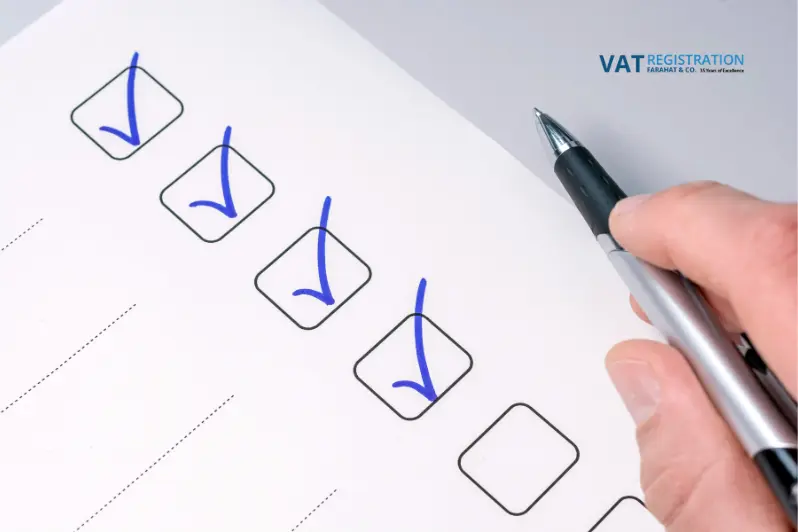For a properly VAT return preparation in UAE, taxable persons have to primarily establish their taxability. It is essential to keep track of the documents and records related to sales, purchases and other transactions to avert complexities upon return filing. This includes transaction dates, description of goods or services provided/received, value of each transaction, name of the country where the goods or services were received from/ sold to and the applicable VAT rate. It is also imperative to ensure that all financial records are up-to-date before submitting the return for filing. This encompasses, reconciling bank statements, verifying accuracy of transactions in accounting books and preparing profit and loss accounts.
In this blog we will introduce you to the checklist that our experts use when filing VAT returns. But keep in mind that this blog may not be enough because each taxable person has a special case. Therefore, you are highly advised to obtain advice from a VAT expert.
Preparation of Checklist for VAT in UAE
1. Understanding of VAT Requirements
It is essential to understand the specific requirements for VAT registration and its implications in the UAE. The Federal Tax Authority has set out comprehensive guidelines on the introduction and implementation of value-added tax, including a detailed explanation of how it works and arranging Preparation of VAT Return.
2. Staff Training
To ensure the staff’s readiness and to meet tax requirements, it is important to provide the staff with adequate professional training. This covers facets such as the obligations that have to be met by businesses and individuals, record keeping requirements, invoicing rules and the filing of returns. Providing your staff with appropriate training ensures the organization’s compliance to VAT standards.
3. Professional Advice
It is advisable to seek professional advice from regulated tax experts to ensure the business’s preparedness to VAT compliance. Top tax agents can provide professional guidance and advice on managing tax obligations and also assist to identify potential cost savings.
4. Updated IT Systems
As VAT is a transaction-based tax, it is important that your IT systems are able to manage the new taxation requirements. If you are currently using an accounting system, then it is important to check that it has been updated to include the necessary VAT functionality. Alternatively, you may need to invest in a new system that is fully capable of managing the complexities of VAT.
5. Registration for VAT:
The Federal Tax Authority has set out a criterion that must be met before a business can register for VAT. This includes the submission of required documents, the payment of any applicable fees and the completion of a registration form. Once registered, businesses must maintain their tax records in accordance with the VAT regulation standards. To which failure to comply accrues penalties upon corporations.
6. Management and Controls:
It is essential to have robust management and control systems in place to ensure that your business complies with the latest VAT regulations. This includes setting up procedures for filing returns, handling refunds, reconciling accounts and dealing with disputes. Additionally, you should also review your internal processes to ensure that they are compatible with the new taxation rules. This will help to reduce the risk of errors and ensure that your organization is compliant.
VAT Return Preparation Checklist
1. Evaluate your transactions
Before starting the process, review all your invoices, payments and other documents related to the sales and purchases of goods and services. Verify that the transactions are recorded accurately in your accounting records.
2. Collect data
Gather all the information needed to prepare the VAT Return. This may include invoices, purchase orders, receipts, delivery notes and other documents related to your business activities during the reporting period.
3. Calculate the VAT payable
Ensure that you have calculated the correct Value Added Tax amount based on your taxable supplies or purchases.
4. Check the due dates
The deadline for filing your VAT return and paying any associated tax varies from country to country. Make sure to check the deadlines for your country and submit your VAT return on time to avoid vat late penalties.
5. Verify filing information
Double-check all the information related to the filing before submitting it. Make sure that all the figures are accurate and correspond with your accounting records.
6. Submit return
Once you are sure that all the information is correct and accurate, submit your VAT return by following these steps.
7. Keep records
It is recommended to keep copies of all the documents related to your filing for at least five years in case an audit is carried out on your business.
Seek the expert services of “VAT Registration UAE”
Filing a VAT return in the UAE can be a complex process for corporations. However, with the right expert advice and preparation, entities can ensure that it is done accurately and timely. Thus, it is advisable for Taxable Persons to avail the services of “VAT Registration UAE” to undertake VAT preparation seamlessly and to ensure compliance with VAT regulations. Contact us today and we shall be glad to assist you.

